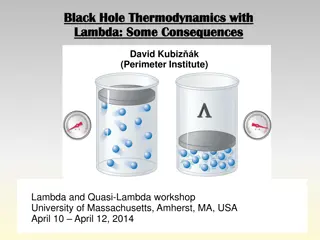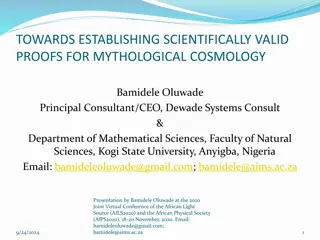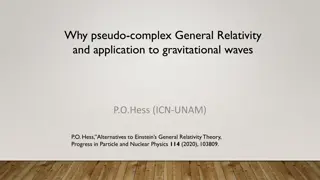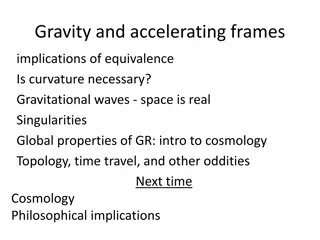Exploring Philosophical Implications of General Relativity: Black Holes, Cosmology, and More
Delve into the profound implications of General Relativity on topics such as black holes, cosmology, and philosophical consequences from Special and General Relativity. Discover how curved geometry allows for different topologies, potential return of preferred frames, the concept of horizons near black holes, and the enigmatic singularities at their centers.
Download Presentation

Please find below an Image/Link to download the presentation.
The content on the website is provided AS IS for your information and personal use only. It may not be sold, licensed, or shared on other websites without obtaining consent from the author. Download presentation by click this link. If you encounter any issues during the download, it is possible that the publisher has removed the file from their server.
E N D
Presentation Transcript
Implications of GR Black holes Cosmology Philosophical fallout from SR and GR Next: Start statistical mechanics
Topology Curved geometry allows different connectedness, i.e. topologies , e.g. how many holes. Consider a cylindrical universe: t The local geometry of a cylinder is flat, but one coordinate is cyclic. If our universe had this topology, there would be a preferred reference frame, the one with the time axis along the cylinder, as shown. This is an example of the situation not manifesting the symmetry of the physical laws. We ll encounter this again later. x Would this mean that Galilean relativity is wrong? Is the geometry of the universe a law or just a fact ? Consider a donut universe (not valid): The local geometry is curved. The time coordinate is cyclic. How can one distinguish past from future here? What about causality? t x There may be valid solutions to GR with this problem.
Return of Preferred Frames? Triplets A, B, and C are not moving together. A and C give each other a shove and head opposite ways. If the universe is finite, they ll ultimately meet up again (and with B too). From B s point of view, they should be the same age, by symmetry. (Assuming matter isn t too lumpy, etc.) Are they? Will A and C be younger than B? What if A is heavier than C? B says C travels faster, should age less. Is C younger than A when they meet again? But A s motion as seen by C is just the exact reverse of C s as seen by A! These inertial (free-fall) frames don t agree whether A and C is older when the meet. But there s an actual objective result. So only one frame (at most) can be right. This result is general for compact topologies.
Horizons Near a small, massive object the gravitational potential, -Gm/r, can be large. Suppose that 2Gm/Rc2 equals 1. Then the redshift becomes infinite. What does this mean? Light emitted from closer than R = 2Gm/c2 cannot escape. An object that behaves like this is called a black hole. The surface at the critical radius is called the horizon. We can t ever learn what happens inside the horizon. (caveats later) How acceleration (gravity) can give a horizon: t a x d d With a big enough lead (and enough acceleration), the light pulse will never reach its target. There is lots of slightly indirect evidence for two varieties of black holes, remnants of supernovas (mass ~5-10 Msun) and supermassive (>106 Msun) black holes at galactic centers (including our own). If we drop something into a black hole we do not ever see it crossing the horizon. From our point of view, its clock keeps slowing down more as it approaches the vanishing point. From its point of view, the trip to the center takes a finite time! Are some things more relative than we said? More later. The existence of hidden regions of the universe has implications (not well understood) for determinism and causality.
Singularities At the center of a black hole is a singularity, where the geometry goes nuts (infinite curvature). If you try to draw a geodesic through a singularity, you find that it isn t uniquely determined. Nothing very bad happens at the horizon. (caveats later!) G.R. theory says the singularity is generic, not just the result of special unrealistic conditions (e.g., perfect spherical symmetry). The cure for the singularity is apparently the breakdown of the theory on a very small scale. (due to QM effects later). The singularity in a black hole isn t a big problem, because it is hidden. However, there s a theorem in GR that there must be at least one visible singularity. The singularity is at the beginning and/or end of time. That is, there cannot be a static, unchanging universe. There must be a big bang or a big crunch (or both). This conclusion upset Einstein so much that he broke the theory trying to evade the prediction.
No static universe This problem is not new to GR. One of Leibniz arguments against Newton s absolute space was: An infinite and unchanging Euclidean space and an absolute time independent of the stuff that is in it implies either: The stuff is also infinite in extent (in space and time). But that is impossible, because it violates Newton s own laws of motion. (I won t prove this.) The stuff is finite in extent. But then symmetries are violated. There is a center (a preferred position) and a corresponding preferred velocity, which ought to be observable. GR extends the problem to spacetime itself. It tells us that the universe must be expanding or contracting. It can t be static. This means that either there is an earliest time or a latest time (or both). This is easiest to visualize with our 2-d sphere analogy. The sphere is a balloon which is being blown up. Some time in the past, the radius of the balloon (the area of its surface) must have been zero. That s the big bang singularity.
The universe is expanding What is observed? (Hubble, 1932) Distant galaxies are moving away from us. The farther they are, the faster they are receding (a linear relationship). This means that at some time in the past, they were all right here ... The whole universe was squashed together. This does not violate relativity. There is no center (preferred location). Suppose I have several friends: A is 10 meters from me, moving away at B 20 C 30 1 m/s 2 3 A' Me A B C 1 m/ s 1 m/ s 2 m/ s 3 m/ s 10 m 10 m 10 m 10 m If they have been moving at a constant speed, I can say that 10 seconds ago, each was at my present location. Notice that A sees exactly the same thing that I do. (Different people, but the same relationships.) The quantity that describes this motion is H = 0.1 m/s per meter . H is the Hubble expansion parameter. 1/H = 10 sec, which tells us when the expansion began.
Speed Limit? In our universe, H 1/14 billion years. Implies (adjustments to follow) the universe began ~14 bil years ago. If my friends are slowing down (i.e., they were moving faster in the past), the starting time was more recent than this calculation tells us. If they are speeding up, the starting time would be longer ago But you ask- won't the ones far enough away from you be receding faster than c? Yes- but in GR the speed-limit becomes local: nothing can go right by you faster than c. Anything receding from you faster than c, while belonging to some mathematical extension of the universe itself, would not be directly observable now . Whether it would be observable in the long run depends on the time-dependence of space.
How does GR describe the expansion? Remember our balloon analogy for curved geometry: Think of dots painted on a balloon. As the balloon expands, the dots move apart. GR says the balloon must either be expanding or contracting. It is expanding. The age of the universe is not quite the na ve value of ~14 billion years, due to accelerations. The expansion rate is changing due to the mutual gravitational effects of all the energy in the universe. Will the expansion ever stop? If I throw a ball in the air, will it fall down? There are two simple possibilities. If the attraction is strong enough, and the speed small enough, then the expansion will stop, and the universe will collapse into a big crunch. If not, or if there is a repulsion, then it will continue to expand forever. Right now, it looks as if the expansion will continue forever, although there are some untested extrapolations.
There is no edge, but there is a horizon Even though the universe is expanding, it is not expanding into anything. There is not an edge to the matter, beyond which there is only empty space. There is a GR analog to the edge, however. There is a horizon, dependent on the observer. The linear relationship between distance and speed tells us that beyond a certain distance (~c/H 14 billion light years) the stuff out there is moving away at faster than light speed. I.e. space is expanding so fast that it is being carried away faster than the speed of light. Why is is in quotes? In standard co-moving coordinates, the distance across now is a lot bigger than 28 bil ly. Doesn t this violate special relativity? What's left of the SR speed-limit is the constraint that any local measurement of a speed give c or less. Inferred speeds of parts of the universe with which communication is impossible are not governed by that constraint.
Did the Big Bang really happen? Besides GR theory and the Hubble expansion main evidences for the big bang are The relative abundances of the light nuclei (H, D, He, Li) are ~correctly predicted by the BB theory. the cosmic microwave background. http://astro.berkeley.edu/ ~mwhite/darkmatter/bbn.html
Cosmic Microwave Background Spectrum When the universe was much more compressed, it must have been much hotter than now. Hot objects glow with thermal radiation. Before the universe cooled to about 3000 K, it wasn't transparent, since when atoms are heated up above that the electrons fall off. Loose electrons are very good light absorbers/ reflectors, as in metals. So we should see back to the point at which it first became nearly transparent, at about 3000 K and ~400,000 years old. It shouldn t look like a 3000K surface because the universe has expanded diluting the light and stretching out its wavelengths. It should look like it s at ~2.7 K. Only one adjustable parameter for the whole curve! Predicted by Gamow, Alpher and Herman in the 1940s and accidentally discovered in 1964 by Penzias and Wilson. Many details are now understood in terms of more elaborate BB theories.
Does the Earth go around the Sun? Let s revisit this question, maybe for the last time. We concluded that the Earth orbits the Sun (approximately) because otherwise we would have to throw out the whole Newtonian framework that described not only planetary motion, but pendulums, etc. Now we have thrown out Newton s framework anyway, and replaced it with a different (and more generally accurate) one. What happens in our new framework? The GR laws are the same for an "accelerated" reference frame (such as the Earth) as for any other. However, there are still reasons for preferring reference frames that are near to the old "non-accelerated" ones. In an "accelerated" reference frame (e.g., rotating or moving in a circle), the gravitational field does not vanish at large distances, and distant space is not flat. We do not actually know the very-large scale geometry of space-time, but with a more conventional frame, at least a large patch of our universe can be described as very nearly flat. If we want to convert easily between a correct GR description and a very good Newtonian approximation, the conversion is much simpler if the GR description uses a conventional reference frame.
An Answer? So we have a nice argument for using frames in which the Earth spins and orbits the Sun, but it doesn t carry the same weight as the old Newtonian one, in which non-inertial observers get the wrong laws of physics. We're stuck with GR whichever reference frame we use. BTW- We know that GR or QM is wrong, if pushed to extremely small length scales. Almost no-one thinks that QM will be wrong in such a way as to allow GR to be right. Does the Sun go around the Earth or does the Earth go around the Sun? And, incidentally, why is it dark at night?
Where do we stand, after SR and GR? Newton s hunch about action at a distance was correct. With fields and finite propagation speed, it is gone. The ether is also gone. Has it been replaced by spacetime? Not in a local sense, although there is the possibility that the global topology of the universe gives us a preferred reference frame. There is no evidence for this. (but there is a microwave average frame) Geometry is empirical. (Kant was wrong.) We will question some of our other basic beliefs when we study QM. Mach s hope that the large scale motion of the matter in the universe can explain inertia is not fulfilled by GR. (See Sklar, p. 79) The geometry of spacetime is not determined solely by the objects within it, an argument against relationism. The expansion of the universe solves Olber s paradox. Distant galaxies are dimmer than previously expected as a result of the cosmological red shift. So now we know why it's dark at night! There actually is a glow from all directions- it's just been lowered to 2.7K (rather than the original effective T, near that of a star surface) by the stretching of space. The existence of horizons implies a loss of knowledge and, possibly, of determinism. Stay tuned.
The nature and status of scientific theories What does it mean to say that Copernicus was right and Ptolemy wrong, or that SR is correct and the ether theory wrong? Clearly, agreement with direct observation is important. However, new theories sometimes change the meaning of statements in such a way as to make direct comparison difficult. Even the notion of what is directly observable can change (e.g., time comparisons). Does the Earth go around the Sun? Some of these changes are (or appear to be) just a matter of convention. Suppose two competing theories predict exactly the same experimental consequences. Are they really different theories? They might incorporate completely different metaphysical frameworks.
Criteria for Judging Theories If full correctness may not be applicable, what about makes a theory preferable? Here are some possible criteria: Intrinsic plausibility? Conservatism? Simplicity? Intrinsic plausibility: Not so good. Ptolemy was more plausible than Copernicus until we learned to think differently. Essentially, "plausibility" in this context is another word for preferability, so we still need to find what makes a theory more preferable. Conservatism (make the fewest changes): This is very powerful when the old theory has worked well. We would be very reluctant to abandon conservation of energy. It can t be the whole story, because sometimes we have to change theories. Simplicity: Simplicity is somewhat in the eye of the beholder. Is the non- Euclidean geometry of GR simpler than an alternative theory which keeps the geometry and complicates the dynamics? But there can be a more-or- less objective count of how many parameters are adjustable in a theory. The more adjustable parameters (Ptolemy) the less impressive is the fit to observation. There are Bayesian ways to formalize this. Term paper?
theory and the external world This central issue for the philosophy of science is dormant as long as everyone works within the same conceptual framework (Kuhn s "paradigm"). When there are changes, then people begin to worry about the meaning of the new theory. More big changes are coming up. The shifts brought about by SR and GR are small compared to what QM will do. Meanwhile, SR and GR are forceful reminders that the foundations of our mental models of the world are not secure.


![[PDF⚡READ❤ONLINE] Cosmology and Particle Astrophysics (Wiley-Praxis Series in As](/thumb/21627/pdf-read-online-cosmology-and-particle-astrophysics-wiley-praxis-series-in-as.jpg)




















